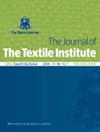三点弯曲循环加载下三维角互锁编织复合材料应力分布的有限元分析
IF 1.5
4区 工程技术
Q2 MATERIALS SCIENCE, TEXTILES
引用次数: 8
摘要
本文对三维层间角互锁编织复合材料在三点弯曲循环加载下的应力分布特征进行了有限元模拟。利用有限元分析模型,建立了织物复合材料在纱线水平的微观结构壳单元模型,计算了循环加载过程中织物复合材料的疲劳行为和应力分布。计算了经纱、纬纱和树脂区的应力分布,显示了机织复合材料的应力差异。经纱承担了大部分的应力或载荷,即经纱的强度比经纱的强度对疲劳设计更为重要。此外,还研究了纬纱与经纱交叉处的应力分布。并与实验结果进行了对比,结果与实验结果吻合较好。根据织物复合材料的应力分布规律,有望开发出提高其疲劳损伤容限的方法。本文章由计算机程序翻译,如有差异,请以英文原文为准。
Finite element analyses of stress distributions of three-dimensional angle-interlock woven composite subjected to three-point bending cyclic loading
This paper presents the finite element simulation of stress distribution features of 3D layer-to-layer angle-interlock woven composite undergoing three-point bending cyclic loading. With the finite element analysis model, a microstructure shell element model of the woven composite at yarn level was established to calculate the fatigue behaviors and stress distribution during cyclic loading. The stress distributions in the warp, weft yarns, and the resin regions have been calculated to show the stress difference in the woven composite. It has been observed that the warp yarns share the most part of the stress or loading, i.e. the strength warp yarn is more important than that of the weft yarn for the fatigue design. In addition, the stress distributions at the locations where the weft yarns crossover the warp yarns have been investigated. The stress degradations of the top and bottom surface of the woven composite panels were also compared with those in experimental and good agreement was found. With the stress distribution in the woven composite, the method of improving the fatigue damage tolerance was expected to be developed.
求助全文
通过发布文献求助,成功后即可免费获取论文全文。
去求助
来源期刊

Journal of the Textile Institute
工程技术-材料科学:纺织
CiteScore
4.20
自引率
5.90%
发文量
149
审稿时长
1.0 months
期刊介绍:
The Journal of The Textile Institute welcomes papers concerning research and innovation, reflecting the professional interests of the Textile Institute in science, engineering, economics, management and design related to the textile industry and the use of fibres in consumer and engineering applications. Papers may encompass anything in the range of textile activities, from fibre production through textile processes and machines, to the design, marketing and use of products. Papers may also report fundamental theoretical or experimental investigations, including materials science topics in nanotechnology and smart materials, practical or commercial industrial studies and may relate to technical, economic, aesthetic, social or historical aspects of textiles and the textile industry.
All published research articles in The Journal of The Textile Institute have undergone rigorous peer review, based on initial editor screening and anonymized refereeing by two expert referees.
 求助内容:
求助内容: 应助结果提醒方式:
应助结果提醒方式:


